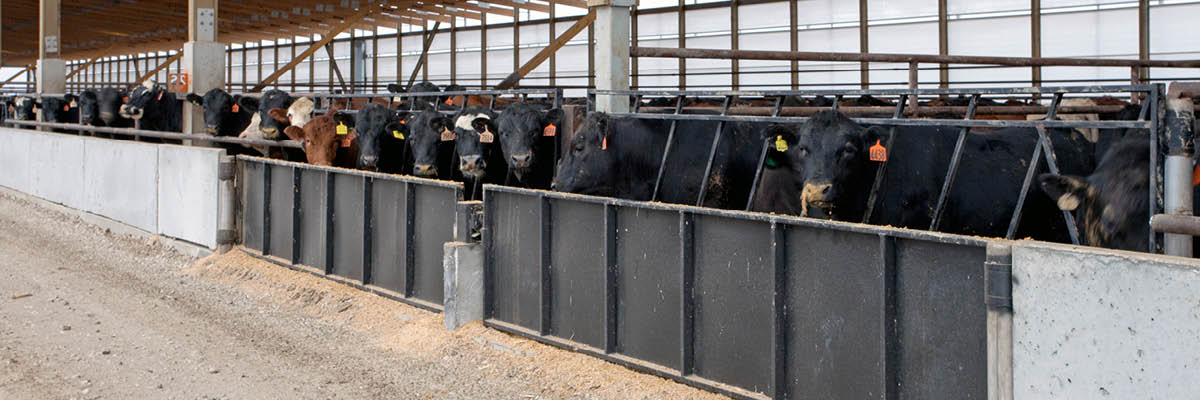4 Reasons Why You Should Feed Cattle Indoors
Deciding to build an indoor cattle feeding facility can be a huge decision. Whether you are currently finishing cattle outdoors or considering diversifying your operation, there are many factors in determining whether or not it’s the right call for your operation and, more importantly, your family. Summit has consulted hundreds of producers and ultimately provided a customized solution that fit the needs of the producer. That consulting process has helped us truly understand how our solution benefits producers or potential producers like you. This is not a comprehensive listing of the benefits of feeding cattle indoors, but highlights a few of the major reasons we hear time after time.
1. Cattle Comfort
When we say cattle comfort, ultimately what we’re really talking about is rate of gain. A comfortable steer is going to pack on valuable weight easier and faster than an uncomfortable steer. There’s a few things that drastically affect cattle comfort.
- Heat: Any experienced cattleman will tell you that when it’s hot outside, the cattle are going to go off feed. They’re not comfortable so they won’t eat as well, meaning every turn of cattle takes a little longer and means less profitability for the producer. Meteorologists estimate direct sunlight accounts for 10-15 degrees of additional heat on top of the ambient temperature. Shade can drastically increase cattle comfort and directly influence performance and ultimately save lives.
- Cold: Jon Weitzenkamp, a third generation cattleman from Hooper, Nebraska, has this to say; “People think the winter is nice if it’s warm. Actually, the winter’s not nice if it’s warm, it’s nice if it’s dry. That’s the biggest advantage of feeding inside - you have dry. It can be 0 degrees out and if they’re dry, they’re happier. A dry animal is a happy animal. I think that’s one of the most important aspects of feeding inside.”
Dry cattle stay warmer than wet cattle because moisture diminishes the insulating value of the hair on cattle. Cold, stressed animals aren’t going to be putting on weight the same way warm, comfortable cattle will.
2. Fertilizer Value of Manure
A valuable byproduct from feeding cattle is manure. Producers estimate that the manure produced annually in a slatted barn to be $120 per headspace worth of N, P & K. For an operation of 500 or more head, that adds up quickly.
While producers can capture manure from outdoor lots as well as indoor, not all manure is equal. When exposed to mother nature, manure can lose it’s value - nutrients. Runoff from rainwater is a huge concern, not just for the environment, but for the fertilizer value of manure. A large percentage of the nitrogen in manure is in the form of ammonia, a gas. Unless manure is stored and applied properly, much of your ammonia nitrogen can be lost.
3. Labor Efficiency
A major reason producers switch to feeding cattle indoors is the ease of management. Ron Cramer, a producer from Macomb, IL, says that it takes a half hour or less to feed the nearly 500 head in his building, allowing him and his son to keep focus on the others parts of their operation, including row crops and breeding cows.
Jon Weitzenkamp says, “The management time for outside pens is from December through March, because you can really get bit in December and March if you don’t manage outside pens well by cleaning and bedding. If you max out your resources of labor and management in December and March, then you’re going to struggle. As your time gets thin, if you want to continue to expand, inside is definitely one of those tools that can help you continue to manage well.”
4. Risk Management
Whether you’re currently finishing cattle outdoors or considering starting for the first time, a indoor feedlot can help you mitigate risk in your operation.
For producers finishing cattle outdoors, moving your cattle under a roof can decrease death loss from bad weather conditions. Jon Weitzenkamp says this: “If it’s the end of June to the first part of August and we get a day with no wind and high humidity, we know that not only are the cows not going to die, but we know they’re still going to hang in there eating."
For potential producers, finishing cattle under a roof can be a great way to diversify your operations profit streams. Ron Cramer shares his perspective: “You’re increasing the value of your crop versus just hauling it off and paying the trucking on it. You’re marketing it through these cattle and walking it off the farm, I guess you could say.”
Ready to learn more about our facilities? Request your FREE Improving Cattle Profits Info Kit Now.
Do you have more questions that are not covered in this article? If you need help designing and planning, please contact Summit Livestock Facilities at 800.213.0567 or click here to email us. If you are ready to get a price, click here to request a quote and a member of our customer engagement team will help you determine the next steps of your project.


